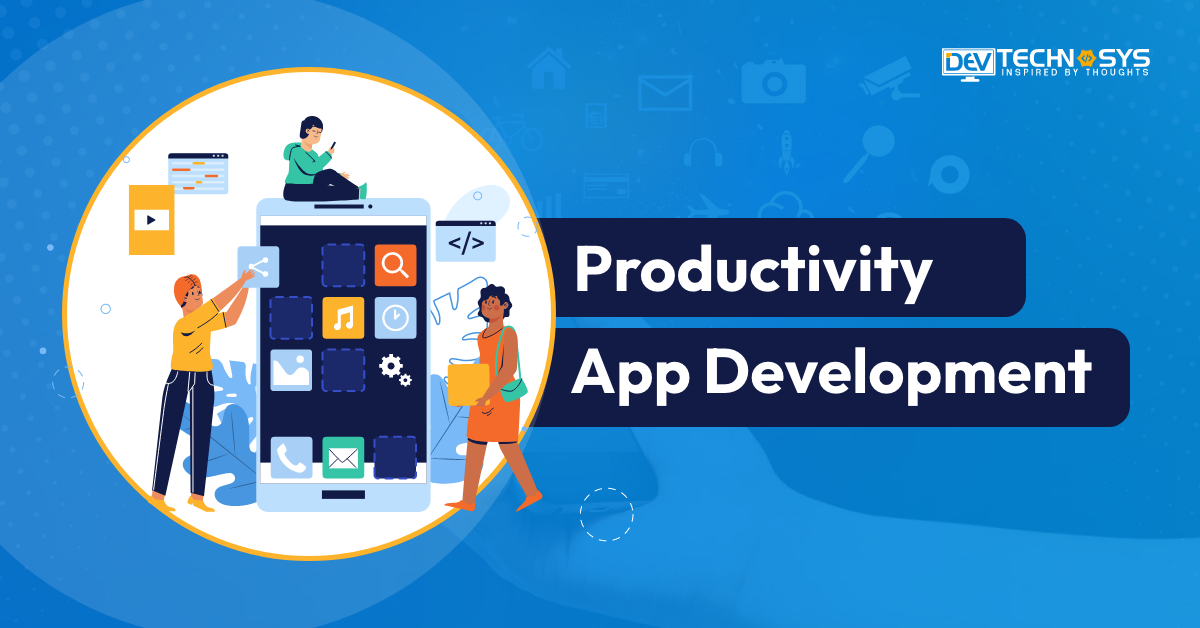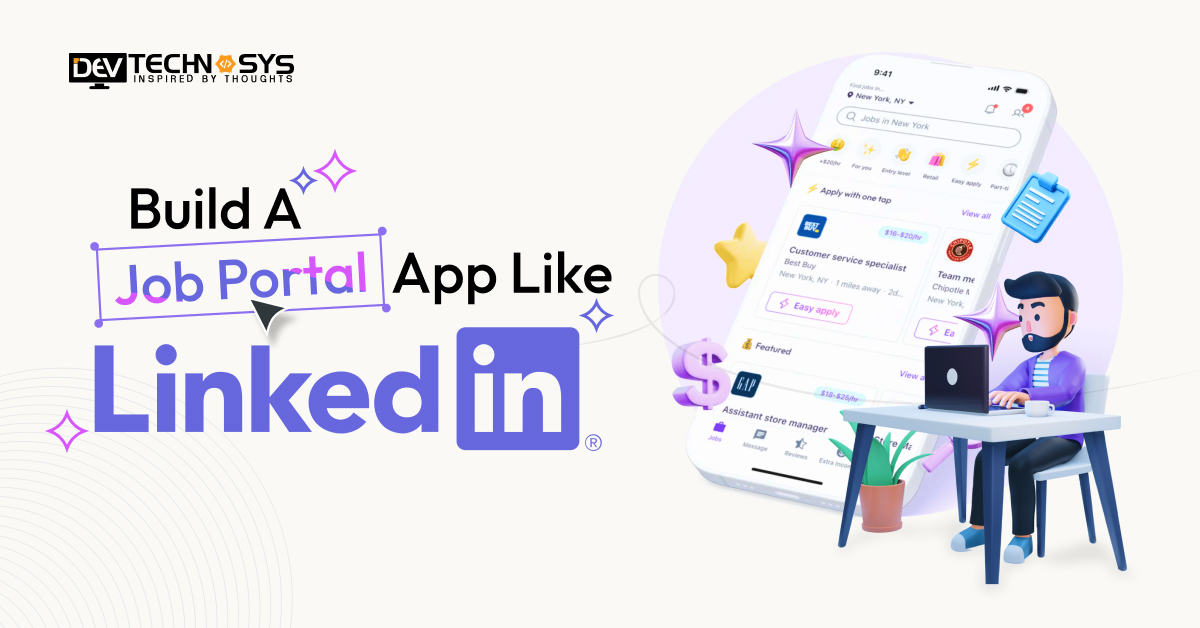Hey there, fellow productivity enthusiast!
Like you, I’m all about conquering my to-do list and squeezing the most out of every 24 hours.
For almost 6 years now, productivity apps have been my secret weapon. Just yesterday, a curious thought struck me: how much is the productivity app development booming the market growing? The numbers I found were incredible!
So, fueled by this newfound knowledge, I decided to assemble a dream team. Our marketing wizards, crack developers, business analysts, and design gurus all came together for a productivity brainstorming session.
The energy was electric, and the insights we unearthed were pure gold. Inspired by this collaborative effort, I knew I had to share it with the world.
That’s why I’m writing this very blog – to create the ultimate guide for anyone who dreams of building a productivity app. If you’re ready to dive into this exciting market, buckle up and get ready to learn!
What Are Productivity Apps & How Does It Work?
To help you in the core, if you are one of the people wondering what productivity software is, Stop right here! Productivity applications are programs made to assist users in more effectively managing their activities, time, and workflow.
Productivity application development can be used for many different things, such as making lists of things to do, setting up meetings, keeping track of deadlines, and working with people.
Productivity app development functions similarly to virtual assistants. How to do it is as works:
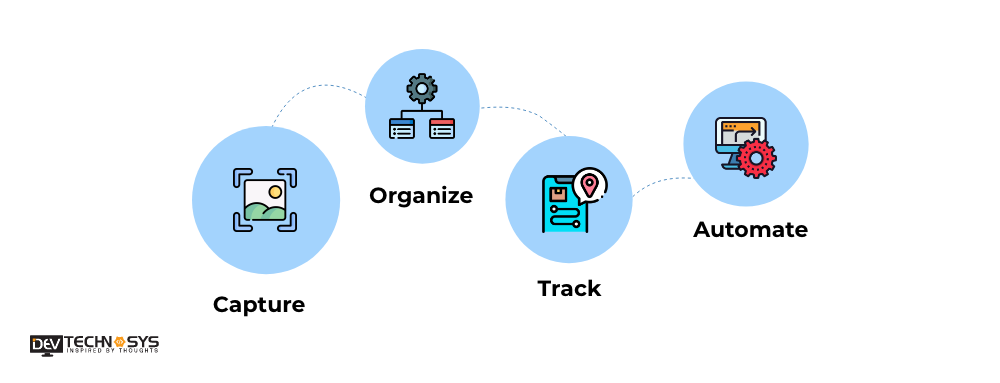
1. Capture:
Using productivity application development can help you take notes, ideas, or tasks.
2. Organize:
You schedule, assign priorities, and classify tasks with the help of a mobile application productivity tool.
3. Track:
You keep an eye on developments, perceive deadlines, and modify your workflow with the help of personal productivity apps.
4. Automate:
A few personal productivity applications can manage repetitive chores, issue reminders, and integrate with other programs.
Types of Productivity App Development
Is your to-do list overwhelming you? Your digital pals in productivity on-demand app development solutions will help you accomplish more by streamlining activities. But where do you begin with so many choices? The following is an overview of the most common categories for productivity app development:
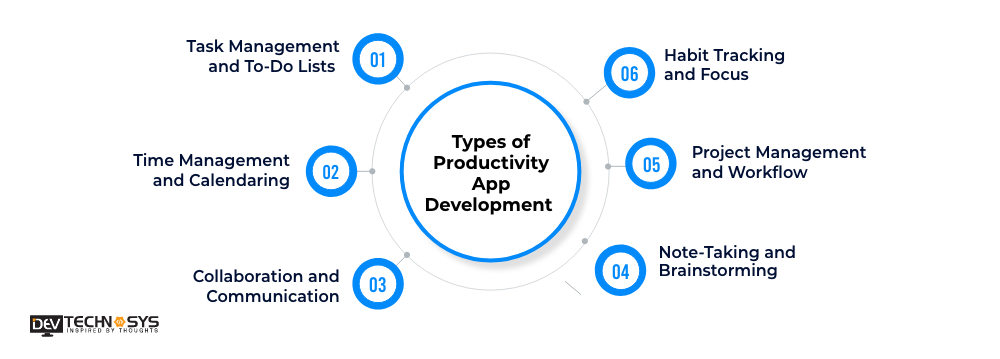
1. Task Management and To-Do Lists
task management & to-do list apps maintain focus on the important things. They track progress, prioritize activities, and organize your work with the help of apps like Evernote.
Features:
- Make to-do lists with break-out activities and deadlines.
- Set priorities and categorize tasks.
- Track progress and completion rates.
- Receive reminders and notifications.
Market Stats:
The global task management software market was estimated to be worth $8.5 billion in 2023 and is projected to grow to $17.2 billion by 2028.
2. Time Management and Calendaring:
Time management & calendaring apps make an efficient schedule, provide time for chores, and stay overwhelmed just apps like Trello.
Features:
- Create calendars with events and appointments.
- Integrate with email and other tools for centralized scheduling.
- Set reminders and recurring events.
- Track time spent on tasks and projects.
Market Stats:
The value of the global market for calendar and scheduling software was $7.3 billion in 2023 and is expected to grow to $12.2 billion by 2028.
3. Collaboration and Communication:
The productivity app development streamlines and facilitates communication to improve teamwork.
Features:
- Real-time messaging and chat functionality.
- File sharing and co-editing capabilities.
- Task delegation and project management tools.
- Video conferencing and online meeting options.
Market Stats:
The global UCC industry is predicted to grow from its 2023 valuation of $52.3 billion to $88.2 billion by 2028.
4. Note-Taking and Brainstorming:
Use digital note-taking tools to efficiently organize ideas, plan projects, and capture thoughts with the help of these types of enterprise product development.
Features:
- Record audio, video, or text notes.
- Arrange notes in notebooks, folders, and tags.
- Work together on notes with coworkers.
- Look for particular information in the notes.
Market Stats:
With a compound annual growth rate (CAGR) of 12.4%, the global digital note-taking market is projected to reach $11.2 billion by 2027.
5. Project Management and Workflow:
Project management & workflow can provide easy overseeing of complicated projects, monitor developments, and work together as a cohesive team.
Features
- Establish milestones and project schedules.
- Assign work and monitor the group’s progress.
- Use Kanban boards or Gantt charts for visual project tracking.
- Combine with additional tools for productivity.
Market Stats:
The worldwide project management software industry is projected to grow from its 2023 valuation of $6.6 billion to $10.7 billion by 2028.
6. Habit Tracking and Focus:
Use habit tracking, the best productivity software, to create wholesome habits, maintain task focus, and fortify your determination.
Features:
- Monitor your progress over time and set targets.
- Get inspired messages and reminders.
- Connect wearable technology to monitor activities.
- Examine trends and pinpoint areas in need of development.
Market Stats:
Shows that the value of the worldwide habit-monitoring app market was $1.2 billion in 2022 and is projected to grow to $3.1 billion by 2028.
5 Popular Productivity Applications
If you want to create a mobile app for productivity just like Todoist & Evernote, this is the time when you should look for its competitors to know more about its strategies.
App Name |
Downloads |
USP |
Ratings (Average) |
| Todoist |
1Cr+ Downloads |
Simple and flexible to-do list with reminders and integrations | 4.4 (Android), 4.7 (iOS) |
| Evernote |
10Cr+ Downloads |
Feature-rich note-taking app with organization tools | 4.2 (Android), 4.5 (iOS) |
| Trello |
1Cr+ Downloads |
Kanban-style board for project management and collaboration | 4.3 (Android), 4.6 (iOS) |
| Asana |
50L+ Downloads
|
Powerful project management tool with team collaboration features | 4.2 (Android), 4.5 (iOS) |
| Forest |
1Cr+ Downloads
|
Gamified focus app that grows a virtual tree while you stay focused | 4.6 (Android), 4.8 (iOS) |
What Are The Financial Benefits For Entrepreneurs Investing In Productivity App Development?
For every entrepreneur, it is important to look for profit before investment. So here we are with a way guide that will help you with 5 incredible benefits for entrepreneurs if they invest in productivity app development. Dive without wasting time.
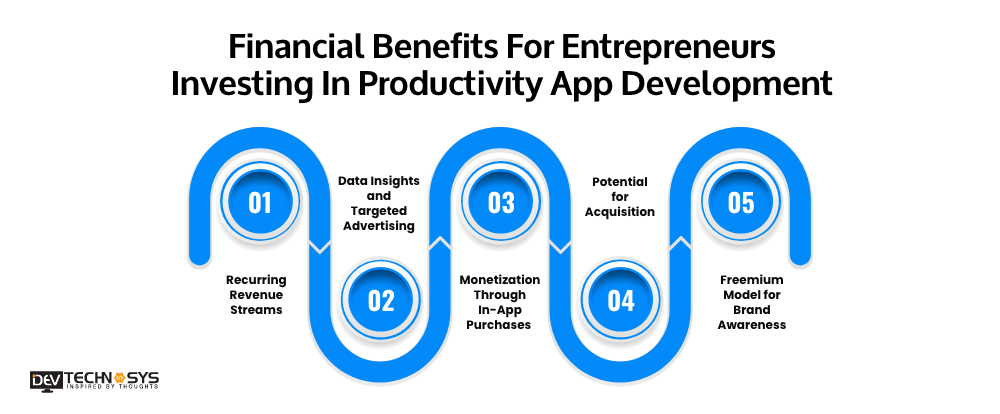
1. Recurring Revenue Streams:
Many productivity app developers utilize subscription models to generate steady profits from customers who pay a monthly or annual rate to get the right of entry. It creates consistent profits and cultivates enduring patron connections. This must have made you curious to know about productivity app development, but wait, there, it’s about to come!
2. Data Insights and Targeted Advertising:
MVP application development services providers can acquire essential insights into user conduct and preferences by reading anonymized user records. It makes it possible for the app to offer tailor-made advertising, which brings in money through collaborations with related manufacturers.
3. Monetization Through In-App Purchases:
In-app purchases permit consumers to get the right of entry to premium features or capabilities within unfastened-to-play models. It gives extra revenue assets from users who need a step forward and experience even fulfilling the desires of a larger target audience.
4. Potential For Acquisition:
Well-mounted tech corporations might also show a remarkable deal of interest in acquiring productivity apps that have a big consumer base and consistent profits. Productivity app development can result in a successful acquisition that offers entrepreneurs a great revenue reward.
5. Freemium Model for Brand Awareness:
Offering an unfastened basic model with restrained capability would attract a good-sized user base. This is the freemium version for emblem cognizance.
This will increase customer satisfaction and logo reputation, which can also subsequently lead to the conversion of unfastened customers into subscribers or users of top-rate capabilities. Connect with an MVP app development company for better, easy-to-use freemium model features to enhance your monetization schemes.
Why is The Demand For Productivity Apps Growing Among Users?
Look at these 5 incredible benefits of productivity apps for users, which have made their demand grow day by day.
1. Increased Workload and Information Overload:
With the advent of the digital age, there is an ever-growing quantity of obligations and records. Individuals want to balance non-public responsibilities, work emails, and non-stop connectivity, which could overwhelm them.
Through using a relevant center for undertaking enterprise, time control, and smart prioritization, productiveness apps let users sense control even in the face of disarray.
2. Rise of Remote and Hybrid Work Models:
The distinctions between work and private existence are getting extra hazy because of the shift toward remote and hybrid work preparations. Through the availability of gear for scheduling, organizing limits, and ensuring that work is finished effectively even when now not within the ordinary office setting, the productiveness of Android app development assists in the maintenance of work-lifestyle stability.
3. Growing Emphasis on Goal-Setting and Personal Productivity:
People are searching out strategies to make the most of their time and attain their very own goals as they locate greater prices on non-public increases. With equipment like aim-placing with reminders, dependency monitoring, and productivity app development reporting, productiveness applications enable users to manage their goals and time.
4. Feature-Rich Apps Serve a Variety of Needs:
There is no one-length-suits-all method within the productivity app development marketplace. Users now have an abundance of options to shape their wishes, ranging from aware-taking and project collaboration to assignment management and time monitoring. With such a range, users can discover the correct mobile app development to improve their personal or expert productivity and optimize their workflow.
5. Automation and Integration:
Contemporary productivity app development easily interfaces with cutting-edge cloud garages, verbal exchanges, and calendaring platforms. As a result, centralized surroundings are created, enabling easy project management, data entry, and collaboration. Furthermore, time-saving gear like repeating sports and automated reminders reduce human mistakes.
5 Stages To Build A Productivity App
Horray you got the stage to build a productivity app! In this section we will provide you 5 step guide to build a productivity app with expertise guidance from its vision to reality. So, without further ado, let’s get started.
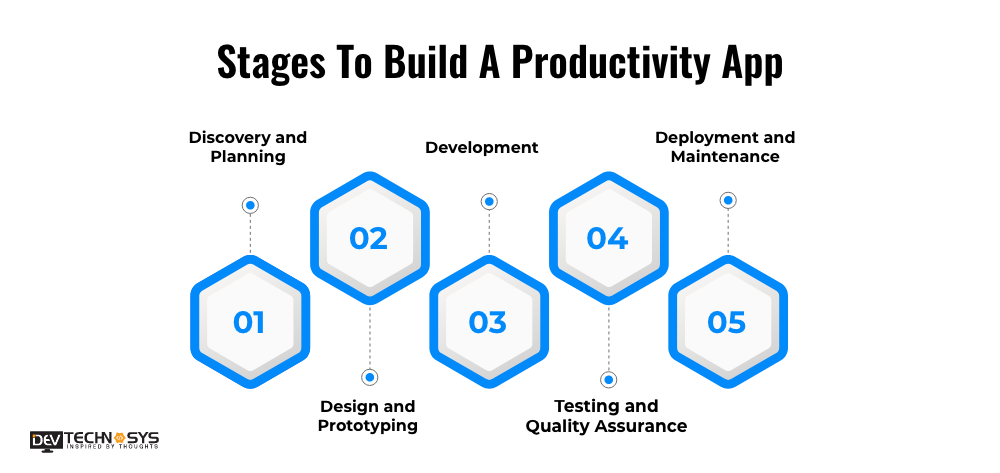
1. Discovery and Planning:
The first section entails cautious making plans and investigation. Recognize the needs of the supposed user base and establish the essential functionalities of the utility.
Establish described objectives and cut-off dates, a radical plan, and the mission’s scope by operating together with stakeholders and hiring a software product development company. To make sure your app stands proud, this step additionally consists of market research and competitor analysis.
2. Design and Prototyping:
During this stage to create a productivity app, the user interface (UI) and user experience (UX) design of the productivity app development are the main priorities. Designers make wireframes and mockups to reveal how the app will appear and what its features are.
A prototype is created to offer a sensible effect on the functionality and design of the app. It helps in getting early comments and enables the specified changes to be made prior to the beginning of development.
3. Development:
Hiring a leading productivity app development company is the main stage of this development process. IPhone app development services providers work on the user interface to ensure it is responsive and clean to apply.
Databases, integrations, and servers are created via a productivity application development company. Maintaining normal contact with the productivity application development company ensures that the software is advanced according to the necessities and schedule hooked up during the making plans section.
4. Testing and Quality Assurance:
Extensive testing is done to discover and resolve defects, making sure that the application is capable of doing so nicely. Your hired productivity app development company will work on usability, performance, and protection, which are all blanketed on this.
Mobile app development company with a satisfactory warranty makes sure the productivity software satisfies all specs and offers a perfect user experience. The software is, in addition, improved by the usage of beta testers’ comments.
5. Deployment and Maintenance:
Last but not least, in stage to create a productivity app, the utility is ready for launch following substantial trying out. During the deployment step, the software is made accessible to users and published to app marketplaces.
To assure that the app keeps functioning at its first-rate after release, ongoing mobile app maintenance & support are critical. To hold the app cutting-edge and purposeful, this includes making frequent updates, together with new functions, and responding to user comments.
Must-Have Features of Productivity App
Now that you know the process of building project management software, it is time for you to learn about its features, which we have covered below.

1. Task Management:
List your responsibilities, assign due dates, and rank them so as of significance to assure an efficient workflow and mission crowning glory on the agenda with the help of apps to increase productivity.
2. Calendar Integration:
Easily streamline scheduling by integrating with modern-day calendars to offer a consolidated view of all appointments, conferences, and deadlines.
3. Collaboration Equipment:
Promote cooperation and mission coordination by enabling file sharing, team conversation, and collaborative undertaking management.
4. Notifications and Reminders:
Notify customers of drawing close time limits and responsibilities to help them live on course and not pass over anything important.
5. Time Monitoring:
Keep track of the quantity of time spent on tasks to gain insights into productivity and to improve painting behavior for accelerated effectiveness.
6. Cloud Syncing:
Provide facts synchronization and accessibility throughout several devices, enabling customers to operate without interruption from any region and with app productivity.
7. Taking Notes:
Make certain you have a place to report your thoughts, assembly minutes, and other pertinent facts so that everything is remembered with productivity Android apps.
8. Analytics and Reporting:
To assist users in knowledge and increasing their performance, provide insights into productivity trends, venture finishing touch prices, and time usage.
9. Customization Options:
Give customers the capacity to customize their project perspectives, notifications, and interface to shape their favored workflows.
10. Security Features:
Put strong security features in the vicinity to protect user facts and guarantee privacy and luxury.
How Much Does It Cost To Develop A Productivity App?
The productivity app development cost appears interesting; how much does it truly cost? So seize a seat, for the reaction is contingent upon other essential factors that affect the productivity of app development cost:
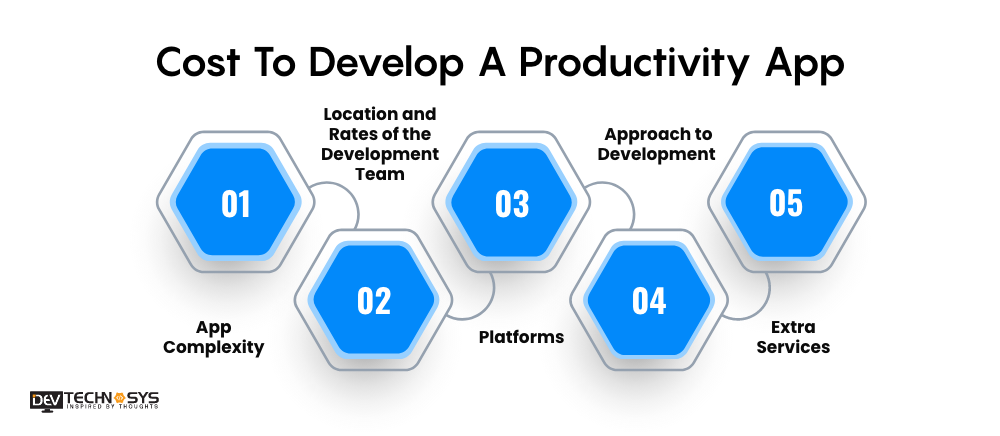
1. App Complexity:
Obviously, a feature-rich, custom-designed app will increase the overall cost of developing a mobile app.
2. Location and Rates of the Development Team:
Hiring productivity app development companies in an expensive location can also affect the total productivity app development cost.
3. Platform (Android, iOS, Web):
Creating apps for both Android and iOS is more expensive than making them for the best one (web app).
4. Approach to Development (In-House, Outsourcing):
While outsourcing productivity app development services providers provides an extra bendy value structure, building in-house dedicated developers necessitates coping with income, advantages, and infrastructure.
5. Extra Services (Admin Panel, Backend):
Adding complex functions or a feature-rich admin interface to manipulate user experience will increase the cost of Android app development.
This is a table that indicates the approximate productivity app development cost for numerous app complexity stages:
Complexity |
Estimated Cost |
| Simple App (Basic Features, Single Platform) | $8,000 – $15,000 |
| Average App (Moderate Features, Multi-Platform) | $15,000 – $25,000 |
| Complex App (Advanced Features, Custom Design, Multi-Platform) | $25,000+ |
These are just estimates of the cost to develop a productivity app. The very last costs to build a productivity app can vary depending on your unique needs and selected development route. However, you are advised to hire a mobile app developer for better estimates depending on your requirements.
How Dev Technosys Can Help You In Productivity App Development?
With more than 13 years of experience, Dev Technosys provides productivity application development services. We provide custom-designed solutions that incorporate the latest features like mange control, time monitoring, and communication tools to fulfill your precise requirements.
Our productivity app development company ensures a wonderful user experience, strong safety, and high-quality design. Additionally, we offer thorough post-launch assistance to keep your software program current and functional.
Hire a flutter developer from Dev Technosys for innovative, dependable, and moderately priced productivity app improvement that will increase the effectiveness and growth of your business enterprise.
FAQ on Productivity App Development
1. How Much Does It Cost To Develop a Productivity App?
The cost to build a productivity app varies based on features and complexity.
- Basic app: $8,000 to $15,000.
- Moderate app: $ 15,000 to $25,000.
- Advanced app: $25,000+.
- Additional costs for maintenance and updates.
2. How Long Does It Take To Build a Productivity App?
The development time depends on the app’s complexity.
- Basic app: 3 to 6 months.
- Moderate app: 6 to 9 months.
- Advanced app: 9 to 12 months.
- Includes planning, design, development, testing, and deployment phases.
3. What Are The Benefits To Develop a Productivity App?
Here are 5 important benefits to create a productivity app
- Enhances user efficiency and organization.
- Streamlines task management and scheduling.
- Boosts user engagement and retention.
- Offers personalized productivity insights.
- Integrates with other tools for seamless workflow.
4. Why Should You Choose Us To Develop a Productivity App?
Choosing Dev Technosys is a smart choice, but to prove to you that we have some claims which you should read:
- Over 13 years of experience in app development.
- Tailored solutions to meet your specific needs.
- Comprehensive post-launch support and maintenance.
- Advanced security measures for user data protection.
- Competitive and transparent pricing models.
5. How Can You Monetize a Productivity App?
This is the five-step monetization guide for a productivity app
- Subscription models for premium features.
- In-app purchases for additional tools and resources.
- Advertisements and sponsored content.
- Affiliate marketing and partnerships.
- Offering a freemium model to attract a broad user base.
